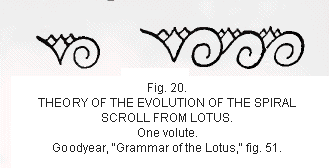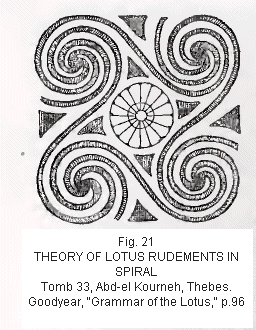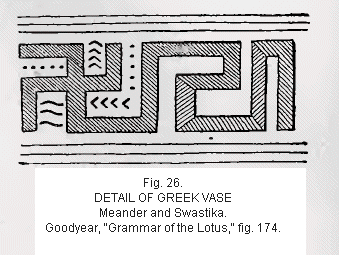

The Swastika
Definitions, Description & Origin
 formed
bands of ornament; or, (3) being
connected to right and left, spread the ornament overran extended surface
as in fig. 21. One of his paths of evolution closed these volutes and
dropped the connecting tangent, when they formed the concentric rings
of which we see so much. Several forms of Egyptian scarabæi, showing the
evolution of concentric rings, are shown in figs.
22, 23, and 24.
formed
bands of ornament; or, (3) being
connected to right and left, spread the ornament overran extended surface
as in fig. 21. One of his paths of evolution closed these volutes and
dropped the connecting tangent, when they formed the concentric rings
of which we see so much. Several forms of Egyptian scarabæi, showing the
evolution of concentric rings, are shown in figs.
22, 23, and 24.By another path of the evolution of his theory, on has only to square the spiral volutes, and the result is the Greek fret shown in fig. 25. (4) The Greek fret has only to be doubled, when it produces the Swastika shown in fig. 26. (5)
 Thus
we have, according to him the origins of the Swastika, as shown in figs.
27 and 28. (6)
Professor Goodyear is authority for the statement that the earliest dated
instances of the isolates scroll is in the fifth dynasty of Egypt, and
of the lotus and spiral is in the eleventh dynasty. The spiral of fig.
19 (above) belongs th the twelfth dynasty. (7)
Thus
we have, according to him the origins of the Swastika, as shown in figs.
27 and 28. (6)
Professor Goodyear is authority for the statement that the earliest dated
instances of the isolates scroll is in the fifth dynasty of Egypt, and
of the lotus and spiral is in the eleventh dynasty. The spiral of fig.
19 (above) belongs th the twelfth dynasty. (7)Professor Good year devotes an entire chapter to the Swastika. On pages 352, 353 he says:
There is no proposition in archæology which can be so easily demonstrated as the assertion that the Swastika was originally a fragment of the Egyptian meander, provided Greek geometric vases are called in evidence. The connection between the meander and the Swastika has been long since suggested by Prof. A. S. Murray. (8) Hindu specialists have suggested that the Swastika produced the meander. Birdwood (9) says: "I believe the Swastika to be the origine of the key pattern ornament of Greek and Chinese decorative art." Zmigrodski, in a recent publication, (10) has not only repropsed this derivation of the meander, but has connected the Mycenæ spirals with this supposed development, and has proposed to change the name of the spiral oranment accordingly.
 *
* * The Equivalence of the Swastika witht the meander pattern is suggested,
in the first instance, by its appearance in the shape of the meander of
the Rhodian (pl. 28, fig. 7), Melian (pl, 60 fig. 8), arcæie Greek (pl.
60, fig. 9, and pl. 61, fig. 12)m, and Greek geometric vases (pl. 56).
The appearance in shape of the meander may be verified in the British
Museum on one geometric vase of the oldest type, and it also occurs in
the Louvre.
*
* * The Equivalence of the Swastika witht the meander pattern is suggested,
in the first instance, by its appearance in the shape of the meander of
the Rhodian (pl. 28, fig. 7), Melian (pl, 60 fig. 8), arcæie Greek (pl.
60, fig. 9, and pl. 61, fig. 12)m, and Greek geometric vases (pl. 56).
The appearance in shape of the meander may be verified in the British
Museum on one geometric vase of the oldest type, and it also occurs in
the Louvre.On page 354, Goodyear says:
The solar significance of the Swastika is proven by the Hindu coins of the Jains. Its generative significance is proven by a leaden statuette from Troy. It is an equivalent of the lotus (pl. 47 figs. 1, 2, 3), of the solar diagram (pl. 57, fig.12, and pl. 60, fig. 8), of the rosette (pl. 20, fig. 8), of concentric rings (pl. 47, fig. 11), of the spiral scroll (pl. 34, fig. 8, and pl. 39, fig. 2) of the geometric boss (pl. 48, fig. 12), of the triangle (pl. 46, fig. 5), and of the anthemion (pl. 28, fig 7, and pl. 30, fig. 4). It appears with the solar deer (pl. 60, figs. 1 and 2), with the solar antelope (pl. 37, fig. 9), with the symbolic fish (pl. 42, fig. 1), with the ibex (pl. 37, fig. 4) with the solar sphinx (pl. 34, fig. 8), with the solar lion (pl. 30, fig. 4), the solar ram (pl. 28, fig 7), and the solar horse (pl. 61, figs. 1, 4, 5, and 12). Its most emphatic and constant association is with the solar bird. (pl. 60, fig. 15; fig. 173).

ENDNOTES:
1. "The Grammar of the Lotus," pl. 8, p. 81. [Back]
2. Ibid., pp. 82-94. [Back]
3. Ibid., p. 96. [Back]
4. Ibid., pp. x, figs. 7-9, p.97. [Back]
5. Ibid., p. 354 [Back]
6. Ibid., p. 353 [Back]
7. Ibid., p. 354, fig. 174. [Back]
8. Cesnola, "Cyprus, its Ancient Cities, Tombs, and Temples, " p. 410. [Back]
9. "Industrial Arts of India," p. 107. [Back]
10. "Zur Geschiehte der Swastika." [Back]
<< Previous Page Next Page >>
© 2004-2007 Northvegr.
Most of the material on this site is in the public domain. However, many people have worked very hard to bring these texts to you so if you do use the work, we would appreciate it if you could give credit to both the Northvegr site and to the individuals who worked to bring you these texts. A small number of texts are copyrighted and cannot be used without the author's permission. Any text that is copyrighted will have a clear notation of such on the main index page for that text. Inquiries can be sent to info@northvegr.org. Northvegr™ and the Northvegr symbol are trademarks and service marks of the Northvegr Foundation.

|